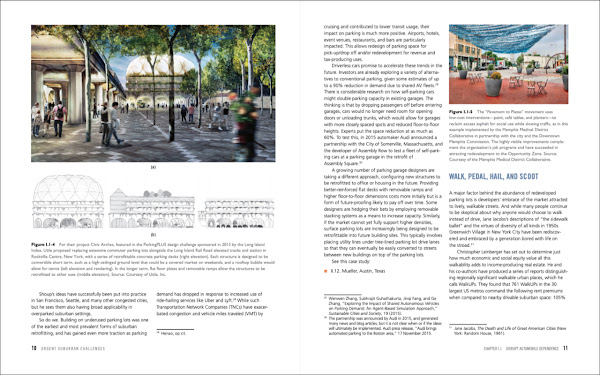Case Studies in Retrofitting Suburbia
Case Studies in Retrofitting Suburbia: Urban Design Strategies for Urgent Challenges
June Williamson, Ellen Dunham-Jones
Wiley, January 2021
Hardcover | 8-1/4 x 10-1/4 inches | 272 pages | English | ISBN: 978-1119149170 | $65.00
PUBLISHER'S DESCRIPTION:
REFERRAL LINKS:
June Williamson, Ellen Dunham-Jones
Wiley, January 2021
Hardcover | 8-1/4 x 10-1/4 inches | 272 pages | English | ISBN: 978-1119149170 | $65.00
PUBLISHER'S DESCRIPTION:
This amply-illustrated book, second in a series, documents how defunct shopping malls, parking lots, and the past century’s other obsolete suburban development patterns are being retrofitted to address current urgent challenges they weren’t designed for: improving public health, increasing resilience in the face of climate change, leveraging social capital for equity, supporting an aging society, competing for jobs, and disrupting automobile dependence.
Case Studies in Retrofitting Suburbia: Urban Design Strategies for Urgent Challenges provides summaries, data, and references on how these challenges manifest in suburbia and discussion of successful urban design strategies to address them in Part I. Part II documents how innovative design strategies are implemented in a range of northern American contexts and market conditions. From modest interventions with big ripple effects to ambitious do-overs, examples of redevelopment, reinhabitation, and regreening of changing suburban places from coast to coast are described in depth in 32 brand new case studies.
June Williamson is associate professor and department chair at the City College of New York's Bernard and Anne Spitzer School of Architecture. She is the acclaimed author of Designing Suburban Futures: New Models from Build a Better Burb. Ellen Dunham-Jones is professor of architecture and directs the urban design degree at the Georgia Institute of Technology. She was voted one of the world's 100 most influential urbanists by Planetizen and hosts the Redesigning Cities podcast.
REFERRAL LINKS:
If climate change is the most pressing issue today — and really, following the pandemic, it is — architecture and development needs to focus on two tactics: reusing buildings and increasing densities in areas with low density. The first takes advantage of the embodied energy and carbon found in the structures and materials of existing buildings, while the second elevates the walkability of places and decreases the demand for driving, among other positives. Case Studies in Retrofitting Suburbia, the sequel to the popular and influential Retrofitting Suburbia (Wiley, 2009), addresses both of these approaches, by presenting 32 case studies that involve varying degrees of adaptive reuse, infill, and other strategies aimed at disrupting car dependence, improving public health, and amending other detriments of suburban development in the United States.
One of the first illustrations in the earlier book by June Williamson and Ellen Dunham-Jones is a pair of drawings, a variation on the famous figure-ground drawings in Colin Rowe and Fred Koetter's Collage City, which shows the differences between the urban fabric of traditional cities and those of modern cities planned with large buildings set upon much larger open spaces. Retrofitting Suburbia starts by comparing "urban form" versus "suburban form," immediately giving readers a strong image of their differences and increasing the clarity of the diagrams in the rest of the book, where the latter form approaches the former. Many such figure-field diagrams, as the authors call them, are found in Case Studies (it should also be noted the authors drew the diagrams), illustrating how the various projects retain many existing buildings and also infill the open spaces between them to increase density and enable residents to walk to nearby places for some of their daily needs.
A different type of image pairing is found in the first case study in the new book: slightly elevated before and after photographs of a three-mile stretch of Aurora Avenue North in Shoreline, Washington, where planted medians were installed and dedicated lanes were set aside for bus rapid transit (BRT). Setting aside the fact the project took nearly two decades to implement and the corridor still looks very suburban in nature, it's important that the changes are very clear between before and after. The improvements are dramatic, but they might not have appeared so in figure-ground plans. The next case study, a residential development in Portland, Oregon, is documented in a similar fashion, but the "after" aerial image is a rendering, not a photo. I think images like these two instances are very important. Seeing images of improved streetscapes or new buildings with green roofs or cleaned up waterways are more helpful than plans in convincing skeptical suburbanites that taxes and development money should be oriented to retrofits rather than the status quo.
The 32 case studies are presented in geographical order from west to east, from Washington State to suburban Boston. Some are just a couple pages long, but most are around five pages, with the diagrams and images as described above accompanied by the authors' clear descriptions. But how to jump into the case studies? Each one is "tagged" with a list of the "challenges" that they address; these challenges comprise the first 80 pages of the book, the "Urgent Suburban Challenges" chapter. The six challenges are: "Disrupt Automobile Dependence," "Improve Public Health," "Support an Aging Population," "Leverage Social Capital for Equity," "Compete for Jobs," and "Add Water and Energy Resilience." Designers and planners already on board with the need to retrofit suburbia can probably jump to the case studies in the second half of the book, but people who need to be convinced should definitely read the first half — or told to do so by someone "in the know." These chapters make clear and well organized arguments, with the added benefit of references pointing to relevant case studies. As such, the book should work well as an urban design textbook, particularly when paired with the first book and especially for a studio tackling one of the most challenging places around: suburbia.








